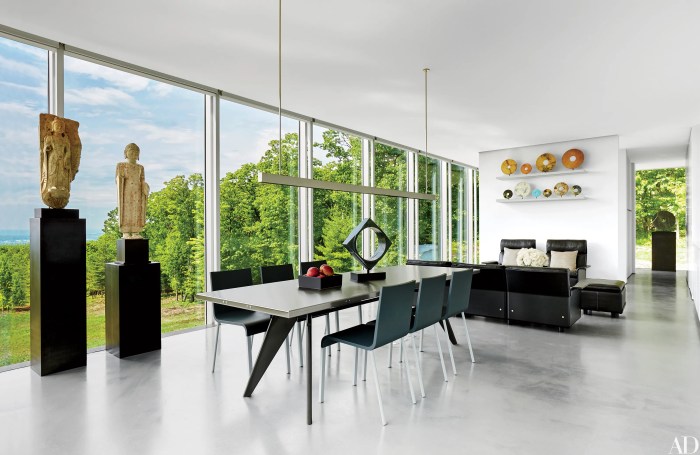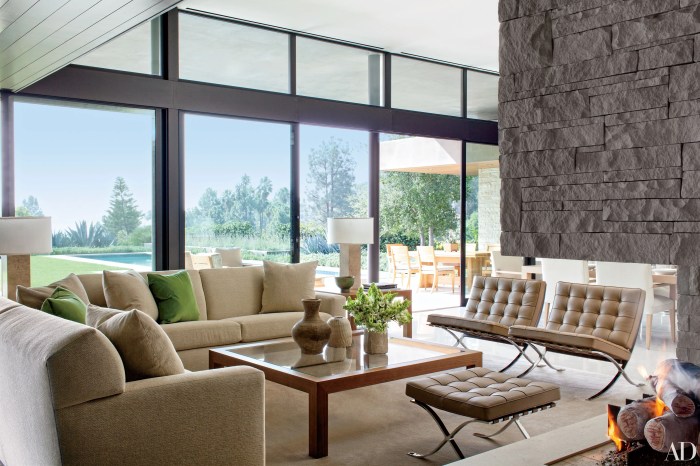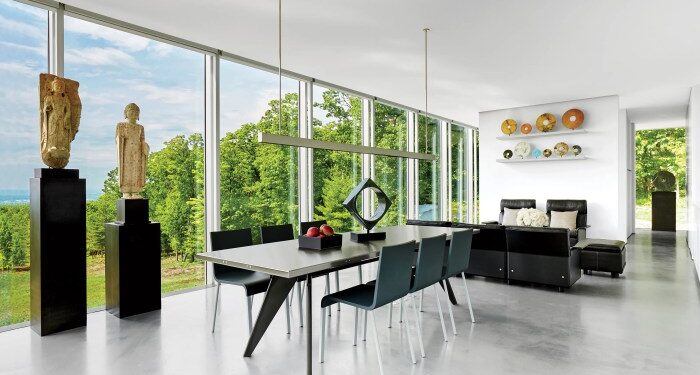Embark on a journey through the world of architectural interior design, where creativity meets functionality in a harmonious blend. From unique aesthetics to strategic space planning, this field offers a rich tapestry of possibilities for designing captivating interiors. Dive in to discover the nuances that set architectural interior design apart from traditional interior design practices.
 Space planning plays a crucial role in architectural interior design as it involves organizing and arranging elements within a space to optimize functionality, efficiency, and flow. Effective space planning can significantly impact how a space is utilized and experienced by its occupants.
. Proper lighting can transform a room, highlight architectural features, and create different moods to suit various activities.
Space planning plays a crucial role in architectural interior design as it involves organizing and arranging elements within a space to optimize functionality, efficiency, and flow. Effective space planning can significantly impact how a space is utilized and experienced by its occupants.
. Proper lighting can transform a room, highlight architectural features, and create different moods to suit various activities.
 In conclusion, architectural interior design is a dynamic realm where innovation and practicality converge to create spaces that inspire and delight. By focusing on elements like space planning, material selection, lighting design, and sustainability, designers can craft environments that leave a lasting impression.
Embrace the artistry and precision of architectural interior design to transform spaces into works of art.
In conclusion, architectural interior design is a dynamic realm where innovation and practicality converge to create spaces that inspire and delight. By focusing on elements like space planning, material selection, lighting design, and sustainability, designers can craft environments that leave a lasting impression.
Embrace the artistry and precision of architectural interior design to transform spaces into works of art.
Definition of Architectural Interior Design
Architectural interior design focuses on the interior spaces of buildings, incorporating elements of architecture, interior design, and decoration to create functional and aesthetically pleasing environments. It involves the planning, design, and coordination of interior spaces to enhance the overall look and feel of a space while considering the structural and architectural elements.Differences from Regular Interior Design
- Architectural interior design involves working closely with architects and builders to ensure that the interior spaces complement the overall architectural design of the building.
- Regular interior design focuses more on the aesthetics and functionality of the interior spaces without necessarily considering the architectural elements of the building.
Key Elements of Architectural Interior Design
Architectural interior design is characterized by the following key elements:- Space Planning: Maximizing the functionality and flow of interior spaces to meet the needs of the occupants.
- Structural Integration: Incorporating architectural elements such as columns, beams, and ceilings into the interior design to create a cohesive look.
- Material Selection: Choosing materials that not only enhance the aesthetics but also complement the overall architectural style of the building.
- Lighting Design: Utilizing natural and artificial lighting to highlight architectural features and create ambiance within the space.
Importance of Space Planning
 Space planning plays a crucial role in architectural interior design as it involves organizing and arranging elements within a space to optimize functionality, efficiency, and flow. Effective space planning can significantly impact how a space is utilized and experienced by its occupants.
Space planning plays a crucial role in architectural interior design as it involves organizing and arranging elements within a space to optimize functionality, efficiency, and flow. Effective space planning can significantly impact how a space is utilized and experienced by its occupants.
Enhancing Functionality and Flow
Space planning directly influences the functionality of a space by determining the placement of furniture, fixtures, and circulation paths. For example, in a living room, thoughtful space planning can ensure that seating areas are arranged for optimal conversation and traffic flow. In a workspace, efficient space planning can enhance productivity by creating designated areas for different tasks.Maximizing Space Utilization
Effective space planning allows for the maximization of available space, making even smaller areas feel more spacious and organized. By carefully considering the scale and proportion of furniture and the layout of elements, designers can create a harmonious balance that enhances the overall aesthetic and functionality of a space.Creating Zones and Hierarchy
Space planning helps in creating distinct zones within a space for different activities or functions. By establishing a clear hierarchy of spaces, such as separating private areas from public ones, designers can improve the overall flow and organization of a space. This is particularly important in open-plan layouts where delineating different zones is essential for clarity and purpose.Promoting Safety and Accessibility
Proper space planning is essential for ensuring safety and accessibility within a space. By considering factors such as clear pathways, ergonomic furniture placement, and adherence to building codes, designers can create environments that are not only visually appealing but also practical and safe for occupants of all ages and abilities.Materials and Finishes Selection
When it comes to architectural interior design, selecting the right materials and finishes is crucial in achieving the desired aesthetic and functionality of a space. The process involves careful consideration of various factors to ensure that the materials chosen not only look good but also perform well in the long run.Impact of Different Materials on Aesthetics
Different materials such as wood, metal, glass, stone, and fabrics can significantly impact the overall aesthetic of a space. For example, using warm wood finishes can create a cozy and inviting atmosphere, while sleek metal finishes can give a more modern and industrial look. The choice of materials should align with the design style and concept to create a cohesive and harmonious space.Considerations for Choosing Materials and Finishes
- Durability: Select materials that are durable and can withstand daily wear and tear.
- Maintenance: Consider the maintenance requirements of the materials to ensure easy upkeep.
- Budget: Stay within budget constraints while choosing materials that offer the best value for money.
- Sustainability: Opt for eco-friendly materials to minimize environmental impact.
- Texture and Finish: Pay attention to the texture and finish of materials to create visual interest and depth in the design.
Lighting Design
Lighting design plays a crucial role in architectural interior design, as it not only illuminates a space but also enhances its atmosphere, functionality, and aestheticsTypes of Lighting and Their Effects
- Ambient Lighting: This provides overall illumination and sets the tone for the space. Soft, diffused ambient lighting creates a cozy atmosphere, while bright ambient lighting is ideal for work areas.
- Task Lighting: Task lighting is focused on specific areas where activities like reading, cooking, or working take place. It helps reduce eye strain and improves productivity.
- Accent Lighting: Accent lighting is used to highlight architectural details, artwork, or focal points in a room. It adds depth and visual interest to the space.
- Natural Lighting: Utilizing natural light through windows, skylights, or light wells not only saves energy but also creates a connection to the outdoors and promotes a sense of well-being.
Enhancing Architectural Features
Lighting can be used strategically to showcase and enhance architectural elements within a space. For example, track lighting can be directed towards a textured wall to create depth and visual interest. Up-lighting can be used to accentuate high ceilings or architectural columns. Similarly, wall sconces can highlight unique design details or artwork. By manipulating light and shadow, designers can draw attention to specific features and create a dynamic environment.Furniture and Fixture Selection
When it comes to architectural interior design, the selection of furniture and fixtures plays a crucial role in shaping the overall look and feel of a space. It is important to carefully consider the criteria for choosing these elements to ensure they complement the design concept and enhance the functionality of the space.Criteria for Selecting Furniture and Fixtures
The criteria for selecting furniture and fixtures in architectural interior design include considerations such as the scale and proportion of the pieces, their durability and quality, as well as their aesthetic appeal. It is essential to choose items that not only fit the space physically but also align with the overall design concept and color scheme.Relationship between Furniture Selection and Design Concept
- Choose furniture pieces that reflect the style and theme of the design concept to create a cohesive look.
- Consider the function of each piece and how it contributes to the overall flow and usability of the space.
- Ensure that the furniture selected complements the architectural elements in the space, such as flooring, walls, and lighting.
Creating a Cohesive Look
- Stick to a consistent color palette and design style throughout the space to create a unified look.
- Mix and match furniture pieces to add visual interest while maintaining a sense of harmony.
- Pay attention to the scale and placement of furniture to ensure a balanced and well-proportioned layout.
Sustainability in Architectural Interior Design
In modern architectural interior design practices, sustainability plays a crucial role in creating spaces that are not only visually appealing but also environmentally friendly. Designers are increasingly focusing on incorporating eco-friendly materials and implementing design strategies that promote sustainability.Eco-Friendly Materials and Design Strategies
When it comes to promoting sustainability in architectural interior design, the choice of materials is key. Designers are opting for eco-friendly materials such as reclaimed wood, bamboo, cork, and recycled glass to reduce the environmental impact of their projects. Additionally, implementing design strategies like passive solar design, natural ventilation, and energy-efficient lighting can significantly reduce the carbon footprint of a space.Examples of Sustainable Design Projects
- One notable example of a sustainable architectural interior design project is the Bullitt Center in Seattle, Washington. This commercial building is designed to be net-zero energy and water, featuring solar panels, rainwater harvesting systems, and natural ventilation to minimize its environmental impact.
- Another exemplary project is the Edge in Amsterdam, known as the greenest office building in the world. This building utilizes a range of sustainable design features, including smart lighting systems, green roofs, and energy-efficient appliances, to achieve high levels of sustainability.
Final Wrap-Up
 In conclusion, architectural interior design is a dynamic realm where innovation and practicality converge to create spaces that inspire and delight. By focusing on elements like space planning, material selection, lighting design, and sustainability, designers can craft environments that leave a lasting impression.
Embrace the artistry and precision of architectural interior design to transform spaces into works of art.
In conclusion, architectural interior design is a dynamic realm where innovation and practicality converge to create spaces that inspire and delight. By focusing on elements like space planning, material selection, lighting design, and sustainability, designers can craft environments that leave a lasting impression.
Embrace the artistry and precision of architectural interior design to transform spaces into works of art.















